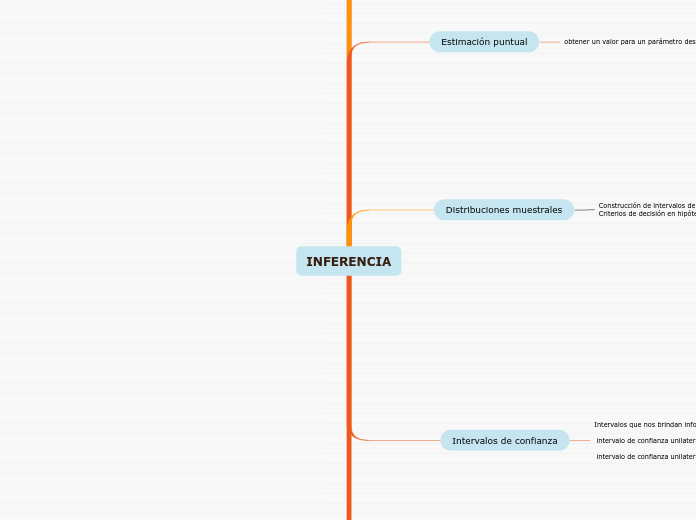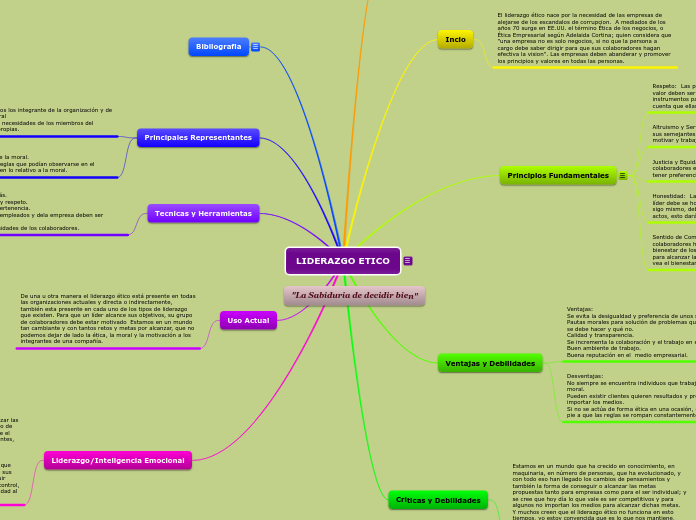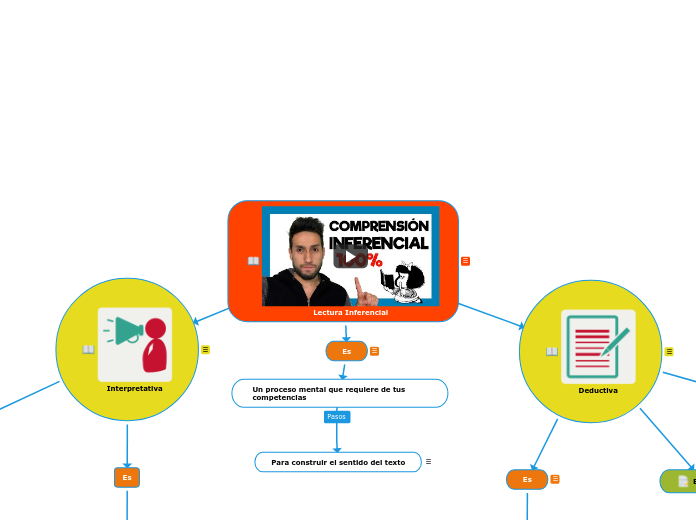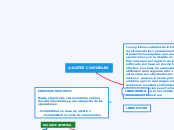INFERENCIA
To name your story, you have to think about the overall message and what you want your audience to understand from the story. Also, make it relevant and easy to remember.
Teoría de errores en experimentación
Diferencia entre e valor obtenido y el valor real de la magnitud.
Factores que influyen
Errores no sistemáticos o aleatorios
Aumento en la variabilidad de las mediciones
Alteran aleatoriamente las medidad
Se producen debido a causas imponderables
Errores sistemáticos
Producen sesgo en las mediciones
Actúan en el mismo sentido
Se reproducen constantemente
Defecto del método de trabajo
Defecto de los aparatos de medida
Determinación del tamaño muestral
intervalo de confianza correcto
Garantiza un precisión determinada
Encontrar el tamaño muestral n
Intervalos de confianza
The middle of the story is where you add layers of complications that will lead to the end. Reveal more about the character's journey. Did their personality go through changes? How did they overcome the challenges? And as you build up the story’s central conflict, make it more personal to that character. Also, from the middle act, you have to lead into the final act.
Intervalos que nos brindan informacion,
intervalo de confianza unilateral izquierdo,
intervalo de confianza unilateral derecho.
Each story has a main character and that character usually needs to solve a problem or challenge. The character's challenge is the one that creates tension throughout the story.
Intervalo de confianza para proporciones
El intervalo de confianza asintótico 1 − ∞ para la proporción p
Intervalo de confianza para dos poblaciones normales
Type in any other challenges which other characters in the story need to face.
R calcularemos los intervalos de confianza
Intervalos para la razón de varianzas: var.test
Intervalos para la diferencia de medias: t.test
para la diferencia de medias μ_D = μ_X − μ_Y.
para la razón de varianzas σ2_X / σ2_Y , con μX y μY desconocidas.
para la razón de varianzas σ2_X/σ2_Y , con μ_X y μ_Y conocidas.
para la diferencia de medias μ_X − μ_Y , con σ_X y σ_Y desconocidas.
para la diferencia de medias μ_X − μ_Y , con σ_X y σ_Y desconocidas pero iguales.
para la diferencia de medias μ_X − μ_Y , con σ_X y σ_Y conocidas.
Intervalos de confianza para una población normal
In most stories, there are 3 challenges. The number 3 is a mystical number symbolizing completeness. Try to come up with interesting challenges with which your character needs to struggle.
See a few examples below:
- turns into a werewolf at night
- is sent back in time
El intervalo de confianza 1 − ∞
para la varianza σ2, con μ desconocida
para la varianza σ2, con μ conocida
para la media μ, con σ desconocida
para la media μ, con σ conocida
Distribuciones muestrales
Construcción de intervalos de confianza,
Criterios de decisión en hipótesis
Estadístico pivote para dos variables normales
Pivote para la razón de varianzas
Pivote para la razón de varianzas conocidas las medias.
Pivote con diferencias de medias
Pivote con diferencias de medias con varianzas desconocidas pero iguales.
Pivote para la diferencia de medias conocidas las varianzas.
Estadísticos pivote para una variable normal
Pivote para la varianza
Pivote para la varianza conocida la media
Pivote para la media
Pivote para la media conocida la varianza
Estimación puntual
The ending of a story is essential. We all know that if the ending is weak, what happened before loses its importance. So make it unpredictable, but fair. A resolved ending answers all the questions and ties up any loose threads from the plot.
obtener un valor para un parámetro desconocido
This is the moment when the main character surpasses the last obstacle and finally faces their greatest challenge.
The climax usually follows one of these patterns:
- realization
- resolution
- choice
Type in your answer.
Propiedades
La robustez
El estimador cambia similarmente
Experimenta modificaciones
La eficencia
Tiene menos varianza
Estimador mas eficiente
La consistencia
a medida que aumenta el tamaño muestral
La media se aproxima al parámetro
La insesgadez
No importa el tamaño de la muestra
La media se tratara de estimar
Simulación de variables aleatorias
Forma mas efectiva
conceptos claros
comprensión mas amigable
fácil de ilustración
Serie de Experimentos
Lógicas mas relevantes del fenomeno
Relaciones Matematicas
Reproduce variables
Métodos de muestreo
In the beginning of the story (or the exposition), you will need to introduce the setting and characters. You might also want to introduce the main conflict. This part of the story is important because it gives the reader necessary background information and maybe even a first insight into a character’s personality.
Tipos
The setting (time & place) of a story can change throughout the plot.
Muestreo por conglomerados
Sensory details include sight, sound, touch, smell, and taste. These details are important because they create depth in your setting.
See a few examples below:
- the smell of fresh bread
- the scent of freshly cut grass
- rain falling onto the windshield etc.
Conglomerados homogéneos entre si
Elementos agrupados de manera natural
Es costoso efectuar un muestreo
Muestreo sistemático
The weather is an important element in your story because it can highly influence the ambiance and the mood of the characters.
Tienden a estar cercanos unos a otros
The most affected character is the main character. Write down here if he/she is affected by these weather conditions in any way. For example, if they lost a family member or their home during a hurricane, etc.
Elementos mas parecidos
Decide if you want to include an element of nature in your story. For example, a rainbow can be a very nice choice for a happy ending. The mist in a story can represent mystery and secrets. A thunder can appear in the background at the moment when the 'bad guy' of the story makes its appearance, etc.
Ordenados en lista
Does your story include catastrophic weather? See a few suggestions below or add your own:
- hurricane, earthquake, storm, etc
Muestreo estratificado
The time of the story can also change. It can describe the event of a single day or can include an entire year's plot. Anyway, don't forget to mention it.
Se comportan de forma diferente
No son homogéneas
Muestreo aleatorio simple
Your story can take place wherever your imagination will take you to.
For example: in an elevator, in an enchanted forest, etc. Don't forget to give details of the environment each time the setting changes, otherwise, the story can be confusing. Also, mention the seasons as each of them has unique weather and events.
características analizadas
Son homogéneas
Caracterizada
Characters are essential to a good story. Usually, the protagonist(s) is/are the most affected by the plot. Introduce a character by focusing on their actions, interests, and occupation, as the physical appearance doesn't make a difference in most cases.
por recoger información
Type in the name of your character.
muestras representativas
What is your character's main goal?
fight Evilfind lovedefeat his/her enemyrule the worldmake friendstime travelmake an awesome discoveryOther
garantiza
Which traits best describe the character's personality? Choose more if necessary:
introvertedloyalkindindependentquick-thinkingadventuresomeidealisticsweet-naturedcalmrisk-takercreativewittystrictfussyweirdclumsyharshaggressivecarelessclingingcowardlycrueldeceitfulimpulsiveOther
contestar preguntas
Choose the type of your chacter:
Protagonist (main character)Antagonist (main character's opponent)Flat (stereotypical character)Round (his/ her personality develops throughout the story)Static (doesn't evolve as a person throughout the story)Dynamic (dramatical change in personality)Confidant (the main character trusts him/ her)Foil (contrasting character who enhances the personality of another character)Other










